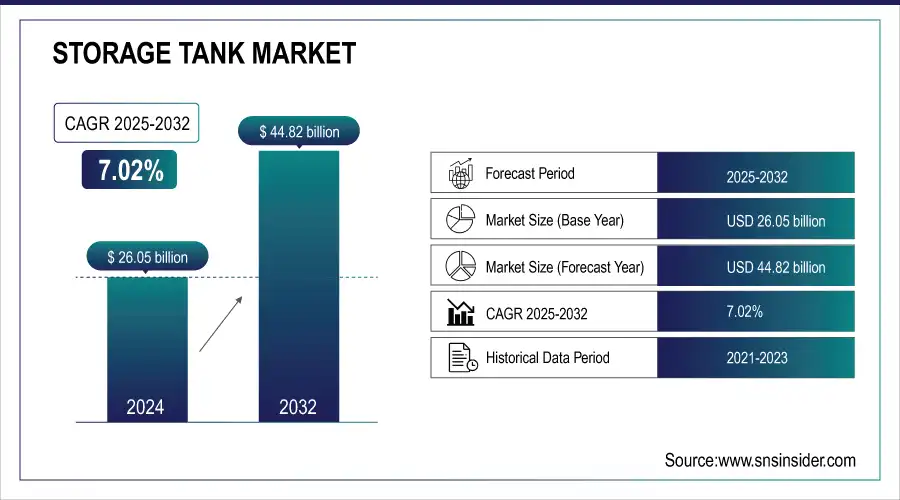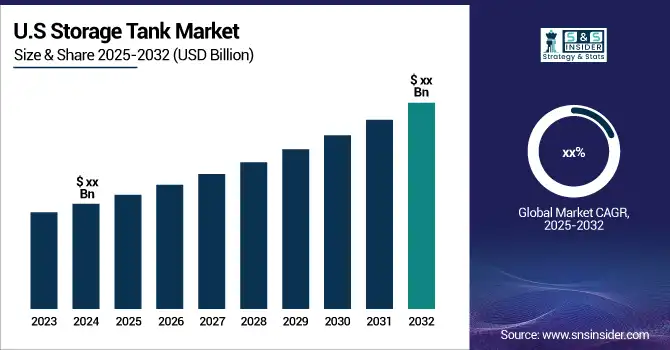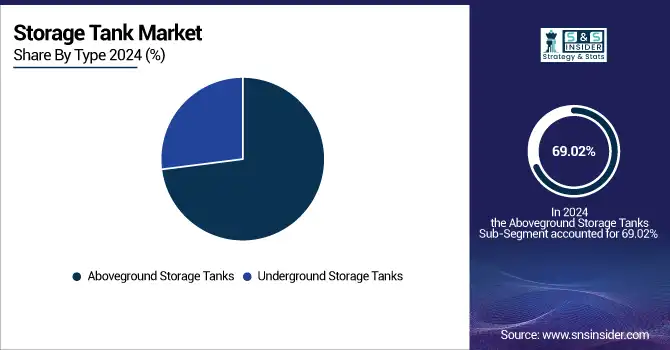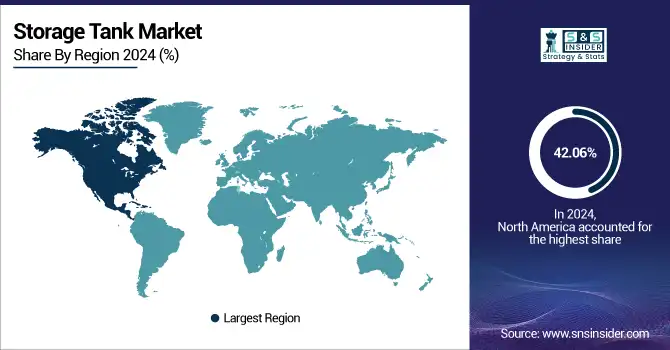Storage Tank Market Report Scope & Overview:
The Storage Tank Market size was valued at USD 26.05 billion in 2024 and is projected to reach USD 44.82 billion by 2032, growing at a CAGR of 7.02% during 2025-2032. The storage tank market has experienced significant advancements due to improvements in material technology and manufacturing processes. The use of high-performance materials like fiberglass-reinforced plastic (FRP), stainless steel, and polyethylene has enhanced the durability and corrosion resistance of storage tanks, leading to lower maintenance costs and increased operational efficiency. Additionally, the integration of smart monitoring systems has enabled real-time tracking and management, optimizing the control of resources. Several factors are driving the market's growth, with rising energy demand being one of the primary contributors. As oil and gas exploration and production activities increase, the need for reliable storage solutions for crude oil, refined products, and natural gas grows.

To get more information on Storage Tank Market - Request Free Sample Report
Opportunities in the market are abundant, particularly in the renewable energy sector. As the world shifts towards sustainable energy sources, there is a growing demand for storage solutions for biofuels, hydrogen, and other renewable energy products. Companies capable of innovating in these areas are poised to benefit. Moreover, the expanding infrastructure in developing countries is driving the need for efficient water and waste management systems, further fueling the market. However, the market faces certain challenges.

Key Storage Tank Market Trends
-
Integration of AI-enabled monitoring systems enhances pattern recognition, real-time fault detection, and predictive maintenance in storage tank operations.
-
Rising adoption of energy-efficient pumping and control systems reduces operational costs while ensuring sustainable tank management.
-
Advancements in smart safety frameworks enable safer human-machine interaction in tank inspections, maintenance, and industrial handling.
-
Development of modular storage tank designs supports scalability, faster installation, and customization across sectors like oil & gas, chemicals, and water.
-
Expansion of cloud-based platforms facilitates remote monitoring, data-driven asset management, and predictive analytics for improved tank reliability.
Storage Tank Market Growth Drivers:
-
Increasing oil and gas consumption is driving the demand for storage tanks, crucial for storing crude oil, refined products, and natural gas in the energy supply chain
The increasing global consumption of oil and gas is significantly driving the demand for storage tanks, which play a critical role in the energy supply chain. As countries around the world continue to depend on petroleum-based fuels for transportation, power generation, and industrial processes, the need for reliable and efficient storage solutions has grown. Storage tanks are essential for storing crude oil, refined petroleum products, and natural gas, ensuring a steady supply and safeguarding against potential disruptions in production or transportation. They serve as a buffer between supply and demand, allowing oil refineries and gas plants to manage fluctuations in production and market conditions. Additionally, as global oil and gas production expands, particularly with new exploration activities and the increasing reliance on unconventional sources like shale gas, the need for large-scale storage infrastructure has become even more critical. Storage tanks enable companies to store excess production during periods of lower demand and ensure availability when consumption spikes. This flexibility is especially crucial in industries that require continuous energy supply, such as manufacturing, transportation, and power generation.
Moreover, advancements in storage tank technology have made it possible to store petroleum products more efficiently and safely, reducing the risk of leaks or environmental damage. This has further fueled the demand for high-quality storage tanks, especially in regions experiencing rapid industrial growth. Overall, the growing reliance on oil and gas underscores the essential role of storage tanks in maintaining energy security and optimizing the global energy supply chain.
-
Stricter environmental regulations are fueling the demand for storage tanks with advanced safety features, especially in industries handling hazardous chemicals and petroleum products
Stricter environmental regulations are significantly driving the demand for storage tanks with advanced safety features, particularly in industries that handle hazardous chemicals and petroleum products. As governments and regulatory bodies worldwide impose stringent guidelines to prevent environmental contamination and ensure public safety, industries are under pressure to upgrade their storage infrastructure. Storage tanks used in the oil, gas, and chemical sectors must now comply with higher safety standards, such as double-walled designs, leak detection systems, and corrosion-resistant materials, to minimize the risk of spills, leaks, and emissions.
Industries dealing with hazardous substances are particularly impacted, as even minor leaks can result in severe environmental damage, fines, and reputational harm. Storage tanks equipped with advanced monitoring technologies, such as sensors for real-time detection of leaks and pressure changes, have become essential to meet these regulatory demands. Additionally, environmentally conscious companies are increasingly adopting tanks made from eco-friendly and durable materials, ensuring long-term safety and reduced environmental impact. These regulations are not just limited to developed nations; emerging economies are also tightening their environmental norms, creating a global demand for safer storage solutions. As a result, companies are investing heavily in upgrading their storage infrastructure to meet these regulatory requirements. This shift toward safer, regulation-compliant storage tanks is expected to further boost the growth of the storage tank market, as industries across sectors prioritize safety and environmental responsibility in their operations.
Storage Tank Market Restraints:
-
The high capital cost of installing large, advanced storage tanks, along with expensive raw materials like steel and fiberglass, poses a significant barrier, especially for small and medium-sized enterprises
The installation of large and technologically advanced storage tanks requires a substantial initial capital investment, which can be a significant barrier for small and medium-sized enterprises (SMEs). These tanks are essential for various industries, including oil and gas, chemicals, and agriculture, but their installation involves high costs due to factors such as engineering, site preparation, and compliance with stringent safety and environmental regulations. Additionally, the prices of raw materials, particularly steel and fiberglass, have been fluctuating, further driving up the overall expense. For SMEs, which often operate with tighter budgets and limited access to financing, these high initial costs can deter investment in necessary storage infrastructure, limiting their operational capacity and growth potential. Consequently, the inability to invest in advanced storage solutions may hinder their competitiveness in industries where efficient storage is crucial for meeting regulatory requirements and customer demands.
Key Storage Tank Market Segment Analysis
By Type
The aboveground storage tanks held the largest revenue share of 69.02% in 2024. Aboveground storage tanks (ASTs) are commonly used because they are easy to install, maintain, and inspect. They can be seen easily, making it simpler to identify and deal with leaks or damages quickly. These tanks are frequently utilized in tasks such as storing fuel, processing chemicals, and treating water, where it is vital to have easy access and monitor them regularly.

By Product
The hazardous tanks held the largest revenue share of 63.89% in 2024. The purpose of hazardous storage tanks is to securely hold substances that present major dangers to health, safety, and the environment. These tanks are built with sturdy materials and innovative safety features to endure the corrosive and reactive properties of dangerous substances. Sectors like oil and gas, chemicals, and waste management heavily depend on these tanks to maintain regulatory compliance and reduce risks.
By Material
The steel tanks held the largest revenue share of 58.04% in 2024. Steel tanks are recognized for their robustness, longevity, and ability to withstand high temperatures and pressures. In sectors like oil and gas, chemicals, and water treatment, sturdy and dependable storage solutions are crucial and commonly utilized. Being able to produce steel tanks in different shapes and sizes increases their versatility and wide range of uses.
By Application
The oil & gas held the largest revenue share of 35.06% in 2024. The oil and gas industry are one of the largest consumers of storage tanks, utilizing them for storing crude oil, refined products, and natural gas. The need for secure and efficient storage solutions in this industry is driven by the growing demand for energy and the expansion of exploration and production activities.
Key Storage Tank Market Regional Outlook
North America Storage Tank Market Insights
North America region dominated the market share over 42.06% in 2024, propelled by the strong industrial foundation and significant infrastructure growth. The successful oil and gas industry in the region, especially in the US, requires advanced storage solutions for crude oil, refined products, and natural gas. Furthermore, strict environmental rules and safety measures require the use of top-notch storage tanks to guarantee safe containment and reduce environmental hazards. Advancements in material technology and the growing emphasis on renewable energy storage are also strengthening the market in North America.

Get Customized Report as per Your Business Requirement - Enquiry Now
Asia-Pacific Storage Tank Market Insights
The Asia-Pacific region is experiencing rapid growth in the storage tanks market, driven by strong industrial growth, urban expansion, and infrastructure advancements. Nations like China, India, and Japan are experiencing significant investments in oil and gas, chemicals, and water treatment sectors, which are increasing the need for advanced storage solutions. The market is driven forward by the region's emphasis on growing its industrial sector and enhancing water management practices. Furthermore, the growing usage of renewable energy technologies and the demand for effective storage solutions provide profitable chances for storage tank producers in APAC.
Europe Storage Tank Market Insights
Europe’s storage tank market is driven by stringent environmental and safety regulations, a mature petrochemical and utilities base, and strong demand for modern infrastructure upgrades. Countries such as Germany, the UK, France, and the Netherlands prioritize corrosion-resistant coatings, secondary containment and leak-detection systems, which raises the specification and value of new tank projects. Growth is supported by investments in hydrogen and renewable-energy storage (seasonal/heat storage and hydrogen storage pilot projects), plus wastewater and urban water-management modernization. Key headwinds include slow permitting in some markets, aging pipeline/tank inventories that require retrofits rather than new-builds, and price sensitivity driven by high energy/material costs
Middle East Storage Tank Market Insights
The Middle East remains a strategic market for large-capacity hydrocarbon storage because of its dominant oil & gas production and logistics hubs. Investment is concentrated on very large crude carriers and onshore storage terminals, export-oriented refining complexes, and petrochemical expansions plus strategic reserves and port terminal upgrades. Political/geopolitical risk and fluctuating crude price cycles affect timing of new projects, but sovereign-backed infrastructure spending, increasing LPG and petrochemical output, and growth in off-shore FPSO/terminal support sustain demand for specialized tanks and containment systems. Water desalination, wastewater reuse and industrial water storage are additional growth pockets in some Gulf Cooperation Council (GCC) countries.
Latin America Storage Tank Market Insights
Latin America shows steady demand led by Brazil, Mexico, and Argentina driven by oil & gas facilities, expanding biofuel production, mining, and municipal water/storage upgrades. Market growth is uneven pockets of rapid investment (refinery upgrades, mining tailings/chemical storage) coexist with regions where funding, regulatory enforcement and local content rules slow new-builds. Currency volatility and supply-chain/logistics disruptions occasionally delay projects, but there is appetite for higher-spec tanks (corrosion-resistant alloys, lined tanks) and for services like retrofitting, inspection and environmental-compliance upgrades.
Storage Tank Companies are:
-
CST Industries, Inc.: (Bolted and Welded Storage Tanks, Flat Panel and Glass Fused Tanks)
-
Balmoral Tanks Ltd: (Steel and Concrete Storage Tanks, Fire Water Tanks, Water Storage Tanks)
-
McDermott International Inc.: (Liquefied Natural Gas (LNG) Storage Tanks, Oil & Gas Storage Solutions)
-
Containment Solutions, Inc.: (Fiberglass Underground Storage Tanks, Petroleum and Chemical Storage Tanks)
-
DN Tanks: (Pre-stressed Concrete Water Storage Tanks, Wastewater and Industrial Storage Tanks)
-
Caldwell Tanks: (Elevated Water Tanks, Ground Storage Tanks, Industrial Liquid Tanks)
-
Sintex Industries Ltd: (Water Storage Tanks, Industrial Tanks, Chemical Tanks)
-
Emiliana Serbatoi S.r.l.: (Portable Fuel Tanks, Diesel Storage Tanks, Polyethylene Tanks)
-
Carbery Plastics Limited: (Fuel Storage Tanks, Chemical Storage Tanks, Agricultural Tanks)
-
Nova Plastic Industries L.L.C.: (Water Tanks, Chemical Storage Tanks, Plastic Underground Tanks)
-
PermianLide: (Oil Storage Tanks, Fiberglass Storage Tanks, Custom Storage Tanks)
-
Superior Tank Co., Inc.: (Bolted Steel Tanks, Welded Steel Tanks, Fire Protection Tanks)
-
Wheeler Tank Manufacturing: (Pressure Vessels, Industrial Storage Tanks, Water Treatment Tanks)
-
T.F. Warren Group: (Epoxy Coated Storage Tanks, Industrial Linings, and Coatings for Tanks)
-
Highland Tank & Manufacturing Company: (Steel Storage Tanks, Aboveground and Underground Storage Tanks)
-
Belding Tank Technologies, Inc.: (Fiberglass Reinforced Plastic (FRP) Tanks, Chemical Storage Tanks)
-
Plascore, Inc.: (Chemical Storage Tanks, Honeycomb Composite Panels for Tank Structures)
-
Hughes Tank Company: (Oilfield Storage Tanks, Fuel Storage Tanks, Mobile Storage Units)
-
ModuTank, Inc.: (Modular Storage Tanks, Portable Storage Tanks, Lined Containment Tanks)
-
ZCL | Xerxes: (Fiberglass Tanks, Petroleum, Water and Wastewater Storage Tanks)
Competitive Landscape for Storage Tank Market:
Hypro is a leading provider of innovative storage solutions, specializing in cryogenic and industrial tanks designed for global applications. Headquartered in India, the company focuses on advanced engineering, high-capacity designs, and safety-driven technology. Hypro continues to strengthen its portfolio by delivering reliable, efficient, and sustainable solutions for diverse industrial needs.
In June 2024: Hypro unveiled a new range of cryogenic storage tanks designed for the global market, enhancing its portfolio with advanced, high-capacity solutions. These tanks cater to the increasing demand for safe and efficient cryogenic storage, ensuring reliability and performance.
Founded in 1902 and headquartered in Saint Paul, Minnesota, USA, 3M is a multinational conglomerate known for innovation across industries, including healthcare, consumer goods, and industrial applications. The company leverages science and technology to develop solutions that improve lives globally, with a strong commitment to sustainability, efficiency, and collaborative advancements.
In March 2024: 3M and HD Hyundai KSOE announced a collaborative research project to develop advanced insulation technologies for liquid hydrogen storage tanks. This partnership aims to enhance storage efficiency and safety, addressing the growing needs of the hydrogen economy.
Utkarsh Pipes, headquartered in Kolkata, India, is a trusted manufacturer of pipes, tubes, and storage solutions. With a strong presence in water management and infrastructure sectors, the company emphasizes durability, innovation, and quality. Its expansion into water tanks demonstrates Utkarsh’s vision to diversify and address evolving market needs with reliable products.
In September 2023: Utkarsh Pipes launched a new product line, Utkarsh Water Tanks. These tanks offer durable and efficient water storage solutions, reinforcing Utkarsh’s commitment to quality and innovation in the storage tank market.
| Report Attributes | Details |
|---|---|
| Market Size in 2024 | USD 26.05 Billion |
| Market Size by 2032 | USD 44.82 Billion |
| CAGR | CAGR of 7.02% From 2025 to 2032 |
| Base Year | 2024 |
| Forecast Period | 2025-2032 |
| Historical Data | 2021-2023 |
| Report Scope & Coverage | Market Size, Segments Analysis, Competitive Landscape, Regional Analysis, DROC & SWOT Analysis, Forecast Outlook |
| Key Segments | • By Type(Aboveground Storage Tanks, Underground Storage Tanks) • By Product(Hazardous, Non-Hazardous) • By Material(Steel, Concrete,Polyethylene,Others) • By Application(Oil & Gas, Chemicals, Water, Food and Beverage, Others) |
| Regional Analysis/Coverage |
North America (US, Canada), Europe (Germany, France, UK, Italy, Spain, Poland, Russsia, Rest of Europe), Asia Pacific (China, India, Japan, South Korea, Australia, ASEAN Countries, Rest of Asia Pacific), Middle East & Africa (UAE, Saudi Arabia, Qatar, Egypt, South Africa, Rest of Middle East & Africa), Latin America (Brazil, Argentina, Mexico, Colombia Rest of Latin America) |
| Company Profiles | CST Industries, Inc., Balmoral Tanks Ltd, McDermott International Inc., Containment Solutions, Inc., DN Tanks, Caldwell Tanks, Sintex Industries Ltd, Emiliana Serbatoi S.r.l., Carbery Plastics Limited, Nova Plastic Industries L.L.C,PermianLide, Superior Tank Co., Inc, Wheeler Tank Manufacturing, T.F. Warren Group, Highland Tank & Manufacturing Company, Belding Tank Technologies, Inc, Plascore, Inc, Hughes Tank Company, ModuTank, Inc, ZCL | Xerxes |

